Your Monstera's curling leaves are sending you clear distress signals about their care. Inward curling typically means underwatering, while downward curls suggest heat stress or nutrient issues. Brown patches with curling point to excessive sunlight, and crinkled edges indicate low humidity. Check your watering routine, maintain 60-80% humidity, and guarantee bright indirect light. Understanding these patterns will help you spot and fix problems before they worsen.
Understanding Monstera Leaf Curl Patterns
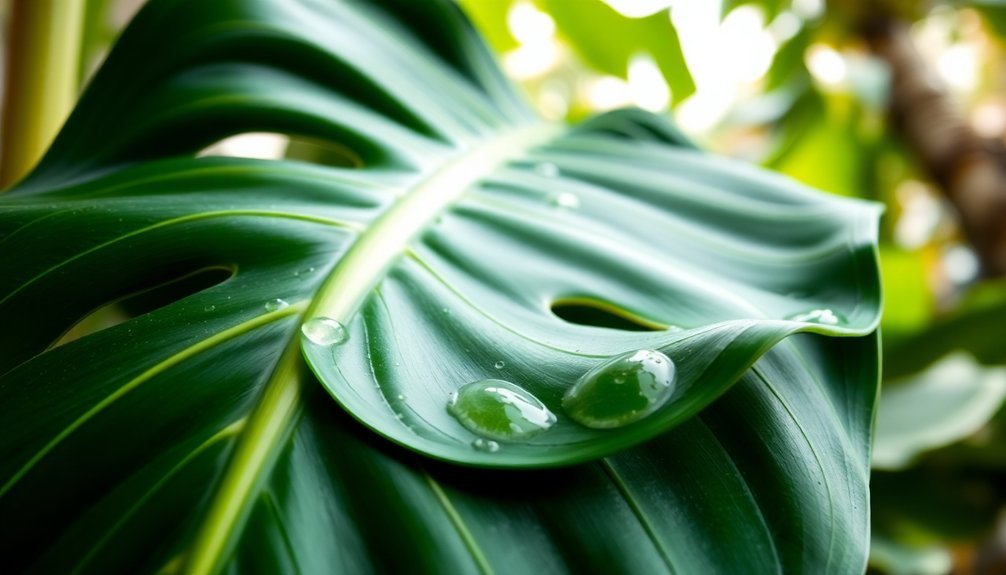
When your Monstera's leaves begin to curl, the pattern and direction provide essential clues about what's stressing your plant.
Inward curling leaves often signal that your Monstera is underwatered, as the plant tries to retain whatever moisture it has left. If you notice the leaves curling downward instead, your plant might be dealing with excessive heat or lacking essential nutrients.
Curling Monstera leaves tell a story: inward curls cry out for water, while downward bends warn of heat stress or nutrient deficiency.
Pay attention to any crinkling in the leaves, especially when paired with dry edges, as this typically points to either low humidity or insufficient watering.
When you spot brown patches along with the curling, your Monstera might be getting too much direct sunlight.
Common Signs of Water-Related Stress
Since water balance plays an essential role in your Monstera's health, recognizing water-related stress signs early can prevent serious damage.
When your plant's experiencing underwatering, you'll notice leaves curling inward as the plant tries to minimize moisture loss through its surface area.
Overwatering presents different symptoms, with leaves typically curling downward and turning yellow. You might also notice soggy soil and potential root rot from oxygen deprivation.
To determine which water issue you're facing, simply insert your fingers about 2 inches into the soil. If it's dry, your plant needs more water, but if it's consistently wet, you're overwatering.
Regular monitoring of soil moisture and adjusting your watering schedule based on your plant's needs will help prevent these water-related stress symptoms.
Light Exposure and Leaf Response
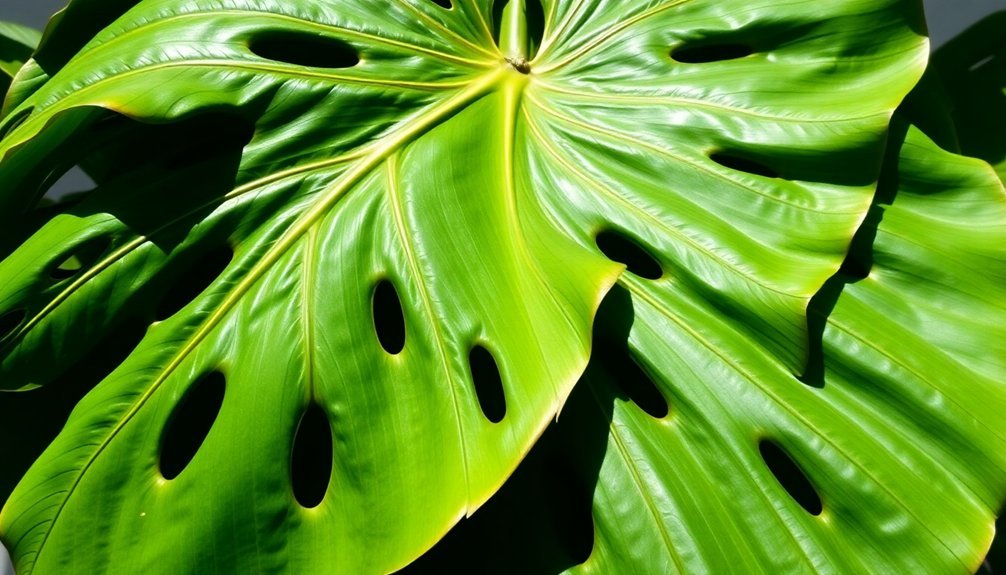
Although Monstera plants are known for their resilience, proper light exposure remains essential for preventing leaf curl. Your plant's leaves will signal when they're receiving too much direct sunlight by curling and developing brown patches. To maintain healthy growth, guarantee your Monstera receives between 10,000 to 20,000 lux of indirect sunlight.
| Light Condition | Leaf Response |
|---|---|
| Too Much Direct | Curling, browning |
| Ideal Indirect | Flat, healthy |
| Filtered Light | Protected growth |
| Seasonal Change | Requires adjustment |
| Low Light | Slow growth |
You can protect your Monstera from excessive light exposure by using sheer curtains or relocating it to a spot with filtered light. Remember to monitor your plant's position throughout the year, as seasonal changes can affect light intensity and duration.
Humidity Requirements for Healthy Foliage
Beyond proper light exposure, humidity plays a key role in preventing Monstera leaf curl. Your plant needs humidity levels above 40%, with 60-80% being ideal for peak growth. When moisture levels drop too low, you'll notice your Monstera's leaves curling inward as they try to retain water.
To maintain healthy humidity levels, you've got several effective options. While misting provides temporary relief, it's not a long-term solution. Instead, try placing a humidifier near your plant, grouping it with other plants to create a microclimate, or setting up a pebble tray with water beneath the pot.
This is especially important if you're growing your Monstera in an air-conditioned space or during dry seasons. Regular monitoring of humidity levels will help you spot potential issues before they affect your plant's foliage.
Soil Composition and Root Health
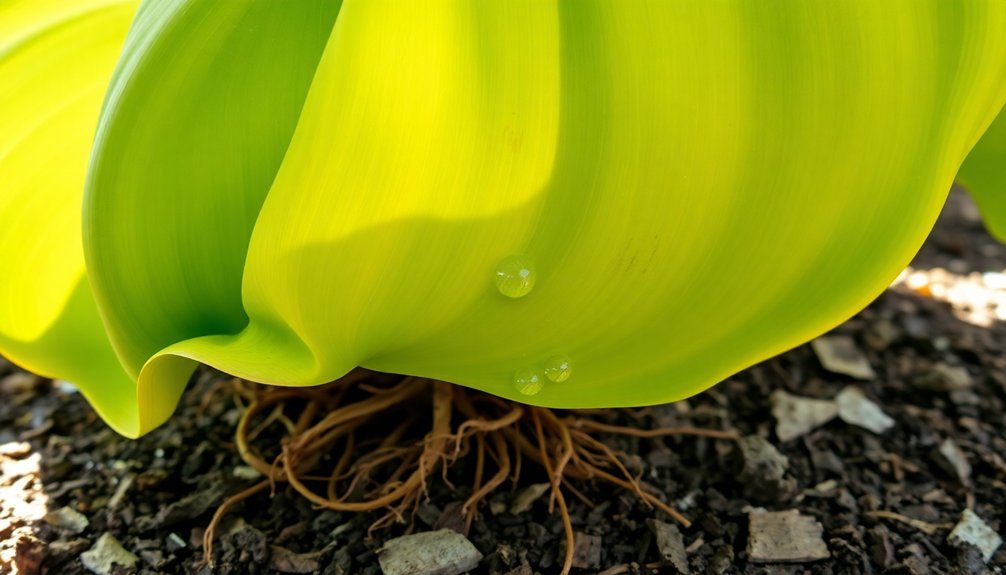
When your Monstera's leaves start curling, the problem often lies beneath the surface in your soil composition and root structure. Your plant needs well-draining soil that's made from a mixture of peat or coconut coir and perlite to maintain proper aeration and prevent root rot.
Check your pot's drainage holes and monitor soil moisture with a meter to avoid waterlogging. If you notice roots circling the pot's interior, it's time to repot your Monstera into a larger container.
Compacted soil can suffocate roots, limiting their ability to absorb nutrients and oxygen. To maintain ideal root health, repot your plant every 1-2 years with fresh soil mix. This practice guarantees your Monstera's roots have enough space to grow and access the resources they need for healthy leaf development.
Temperature Fluctuations and Leaf Behavior
Your Monstera's leaves can quickly react to drafts from windows, doors, or air conditioning units by curling inward as a protective response to sudden temperature changes.
You'll notice the first signs of heat stress when leaves begin curling to minimize water loss, especially if temperatures climb above 86°F (30°C).
Watch for leaf curling near windows or vents, and move your plant to a location with more stable temperatures to prevent stress-induced damage.
Drafts Affect Leaf Health
Since Monstera plants are sensitive to their environment, exposure to drafts can considerably impact their leaf health. When your Monstera faces cold air from windows, doors, or air conditioning units, it'll respond by curling its leaves as a protective mechanism.
These sudden temperature changes disrupt the plant's ability to maintain proper turgor pressure, leading to drooping and curling foliage.
To protect your Monstera from draft-related stress, you'll want to position it away from heating vents, air conditioners, and frequently opened doors or windows.
It's crucial to maintain a stable temperature between 10 to 30°C for ideal growth. During seasonal changes, pay extra attention to your plant's location, as these shifts often bring unpredictable drafts that could trigger leaf curling.
Heat Stress Warning Signs
Understanding heat stress in Monstera plants begins with recognizing their telltale leaf behavior during temperature spikes. When your plant experiences temperatures above 86°F (30°C), you'll notice the leaves curling downward as they struggle to maintain proper turgor pressure.
Your Monstera's leaves will curl more severely when high temperatures combine with low humidity levels, as the plant loses moisture faster than it can replenish it through its roots. This defensive response helps the plant conserve water during stressful conditions.
To protect your Monstera, you'll want to maintain temperatures between 50-86°F (10-30°C) and guarantee proper airflow around the plant. Watch for early signs of heat stress, such as slight leaf curling, so you can adjust conditions before significant moisture loss occurs.
Nutrient Deficiency Signals
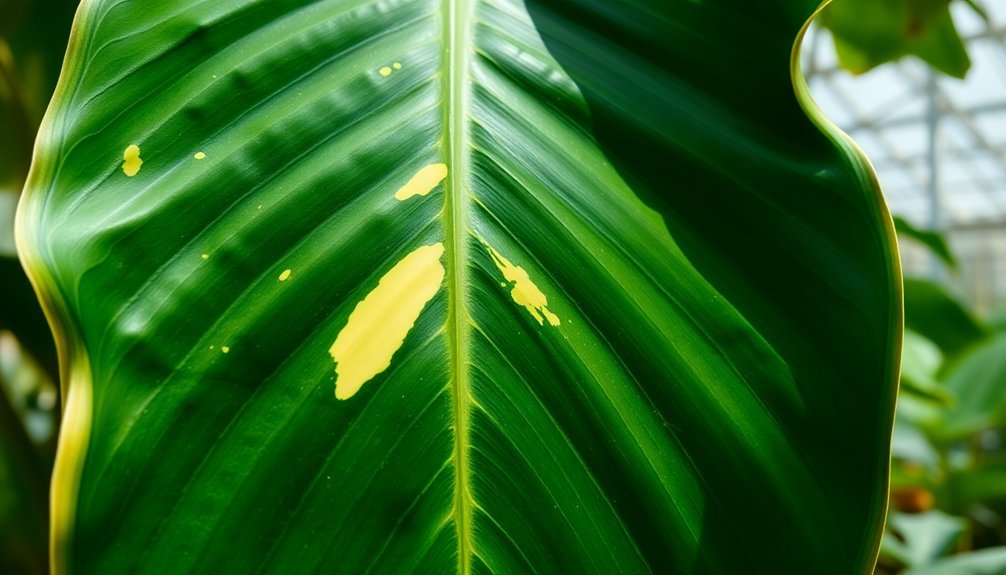
When Monstera leaves begin to curl, nutrient deficiencies are often the hidden culprits behind the plant's distress signals.
You'll notice older leaves yellowing and curling when nitrogen is lacking, while phosphorus-starved plants develop dark green leaves with purple undertones and weak roots.
Pay special attention to potassium deficiency, which causes leaf edges to curl and tips to brown as your plant struggles to manage water properly.
If you spot these signs, don't panic – you can address nutrient deficiencies by feeding your Monstera with a balanced liquid fertilizer designed for aroids.
For best results, conduct a soil test to identify specific deficiencies and make targeted amendments.
Regular fertilization will help prevent leaf curling and maintain your plant's vibrant, healthy appearance.
Pest Infestation Warning Signs
When your Monstera's leaves begin to curl, check the undersides for spider mites' telltale webbing and tiny red spots that signal a moisture-draining infestation.
You'll spot aphid problems by looking for sticky honeydew residue on leaves and clusters of these small pests gathering around new growth.
Watch for silvery streaks or discolored patches on the foliage, as these patterns typically indicate thrips have been feeding on your plant's tissue.
Spotting Telltale Web Signs
The presence of delicate spider webs on your Monstera leaves isn't just a dusty nuisance – it's often a red flag for pest problems. Spider mites, in particular, leave fine, silky webs on the undersides of leaves while feeding on your plant.
You'll want to look closely at these areas, as these tiny pests can quickly multiply and damage your Monstera.
When inspecting your plant, don't forget to check for sticky residue or honeydew on the foliage. This substance often indicates other unwanted visitors like aphids or scale insects.
While examining the leaves, keep an eye out for silvery streaks or damaged patches that might signal thrips. Early detection is vital, so make it a habit to regularly check both the leaves' undersides and soil surface for any signs of infestation.
Sticky Residue Detection
Beyond web-like structures, sticky residue on your Monstera's leaves serves as another key warning sign of pest problems.
When you notice this sticky substance, known as honeydew, you're likely dealing with aphids or whiteflies that have made your plant their home.
This sticky residue isn't just unsightly – it can attract more pests and lead to fungal problems like sooty mold.
You'll want to check your plant's leaves regularly for discoloration, distortion, or small red dots that might accompany the sticky coating.
If you spot these signs, don't wait to take action.
Start by rinsing affected leaves with water to remove the residue and pests.
For more stubborn infestations, treat your Monstera with insecticidal soap or neem oil to eliminate the problem and protect your plant from future pest issues.
Leaf Damage Patterns
Identifying distinct leaf damage patterns can help you catch pest problems before they become severe. When your Monstera's leaves start to curl, combined with other telltale signs, you're likely dealing with a pest infestation.
Look for spider mites' fine webbing on the leaf undersides, which often accompanies curling foliage. If you notice sticky goo on leaves and stems, that's honeydew from aphids, which typically cluster around new growth. This residue can lead to black sooty mold, further damaging your plant.
Watch for silver streaking or unusual discoloration caused by thrips, as these pests create distorted growth patterns.
Make it a habit to inspect your Monstera's leaves weekly, paying close attention to any abnormal spots, webbing, or color changes. Early detection is essential for preventing extensive damage to your plant.
Root Bound Symptoms and Solutions
When your Monstera's roots run out of space to grow, they'll begin circling the pot's interior, leading to a condition known as root binding.
You'll notice yellowing leaves, stunted growth, and poor water absorption as key indicators that your plant needs repotting.
Look for these telltale signs that your Monstera is root bound:
- Roots emerging from drainage holes
- Soil pulling away from pot edges
- Restricted water drainage
- Curling or yellowing leaves
- Visible roots circling inside the pot
To fix a root bound Monstera, transplant it into a pot 2-3 inches larger than its current container.
Use fresh, well-draining potting mix to give roots room to spread and access essential nutrients.
Remember to repot your Monstera every 1-2 years to prevent future root binding issues and maintain healthy growth.
Seasonal Changes and Leaf Adaptations
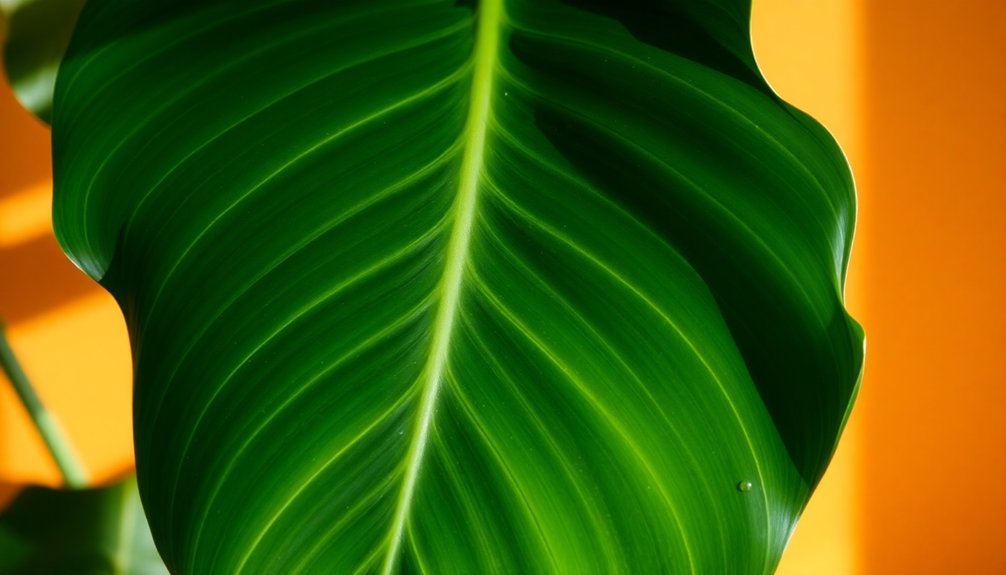
Throughout the year, Monstera plants adjust to changing seasons by modifying their leaf characteristics and growth patterns.
Winter's low humidity often triggers leaf curling as your plant tries to conserve moisture, while summer's heat can cause similar stress responses if you're not maintaining adequate humidity around your plant.
During spring and summer's growing season, you'll need to adjust your care routine to match your Monstera's increased needs.
Watch for signs of stress as light levels change across seasons, and reposition your plant to maintain ideal indirect sunlight exposure.
Pay special attention during the winter-to-spring shift when your Monstera enters an active growth phase – it'll need proper nutrients to prevent stress-related curling.
Regular monitoring and seasonal adjustments to watering, humidity, and fertilization will help keep your Monstera's leaves healthy and flat.
Natural Recovery and Growth Management
As your Monstera shows signs of leaf curling, monitoring its natural recovery process requires a balanced approach to environmental adjustments.
You'll need to create ideal growing conditions by managing key factors that affect your plant's health. Supporting natural recovery means maintaining proper humidity levels above 40% while establishing consistent watering practices that prevent moisture stress.
- Check soil moisture regularly to avoid over or underwatering issues
- Monitor humidity levels and adjust using a humidifier if needed
- Maintain temperatures between 65-85°F for ideal growth
- Apply balanced liquid nutrients during active growing periods
- Gradually increase light exposure to prevent shock
Remember to give your plant time to respond to these improvements.
Your Monstera will show new growth and healthier leaves once it adapts to the ideal environment you've created.
Frequently Asked Questions
How Do You Fix Curling Monstera Leaves?
To fix curling monstera leaves, you'll need to check soil moisture, increase humidity, adjust lighting to bright indirect sunlight, treat any pest issues, and guarantee proper soil drainage through repotting when necessary.
How Do I Fix My Curled Leaves?
Check your plant's soil moisture and water when the top inch is dry. You'll need to boost humidity, guarantee indirect sunlight, inspect for pests, and use well-draining soil to fix those curled leaves.
Will Monstera Leaf Uncurl?
Yes, your Monstera leaves can uncurl when you fix the underlying issue, whether it's adjusting watering, improving humidity, or moving it away from direct sunlight. With proper care, they'll gradually return to normal.
What Does an Overwatered Monstera Look Like?
You'll notice your overwatered Monstera has yellowing, droopy leaves that feel soft. The soil's soggy with a foul smell, and leaves may curl downward. Look for black spots and check roots for brown, mushy texture.
In Summary
You'll find that curling monstera leaves often signal your plant needs attention. By monitoring water levels, adjusting light exposure, maintaining proper humidity, and ensuring healthy soil conditions, you can prevent most leaf curling issues. If you've noticed curling leaves, don't panic – monsteras are resilient plants. Address the underlying cause promptly, and you'll soon see your plant return to its lush, vibrant self.

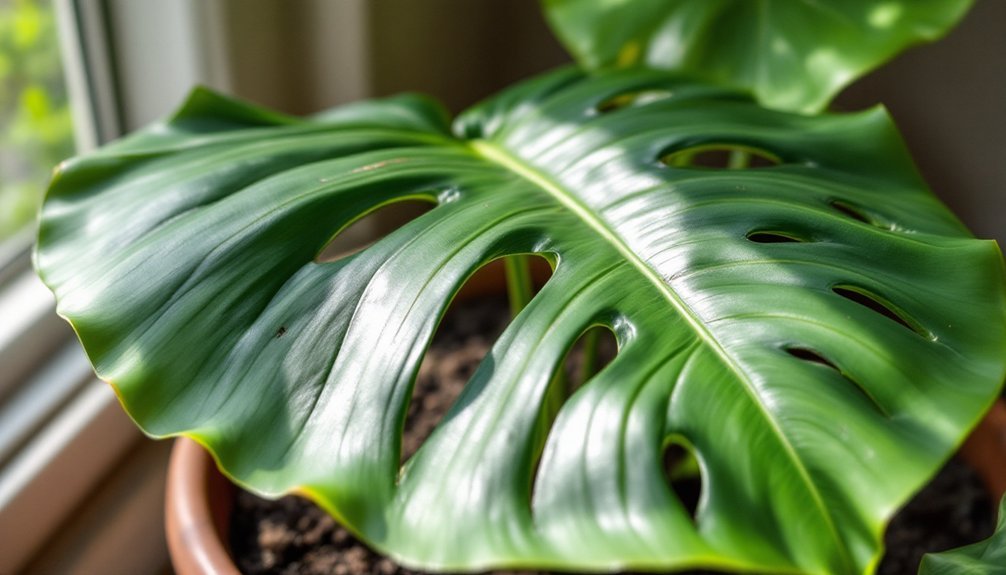



Leave a Reply